#does the old vizer have a name???
Text
Badun Detective Agency: Death Report (edited).

Name Of Detective: Reza Vizer.
Age Of Detective: Five years old.
Date of Report: December 3rd, 2007.
Name Of The Deceased: Francis 'Frankie' Fisher Facilier.
Age Of The Deceased: Three years old.
File Number: 0000.
Report:
The deceased (3, male. Child of Ursula and Dr. Facilier) judging by appearance and whispers around the isle appears to have died from an unavoidable case of malnutrition. However this case appears to be different than others before it because this time it does not seem to be a consequence of parental neglect but rather a consequence of common environmental problems regarding the poor state and amount of the food the isle grows and receives from Auardon each day.
His father and two sisters (5 and 1 at the time) all appeared to be underweight as well as appropriately distressed at the deceased death.
He passed away quietly in his bed in 2004 and was quickly found the next day by his father, and has since been given a proper funeral with the help of Miss Anastasia Tremaine-Lathyn. That is all the information that the agency has at this time and will likely be all the information they will get concerning the manner. The matter should not be brought up to the family or in the presence of his possible mother, Miss Urusla Olympian, or her sister and their children on fear of great bodily injury and a lifetime ban from the Arcade, Dragonhall, and Urusla's fish and chips.
Reza signing out.
Oc belongs to @dragoneyes618 .
Requested by @panthera-tigris-venenata .
#the badun agency files#the badun detective agency files#the badun detective agency#the badun detective agency au#descendants#disney descendants#disney descendants au#descendants au#the faciliers#etc.#frankie facilier#francis facilier#disney descendants original character#descendants original character#descendants original characters#disney descendants original characters#disney descendants ocs#disney descendants oc#disney descendants alternate universe#descendants alternate universe
11 notes
·
View notes
Photo



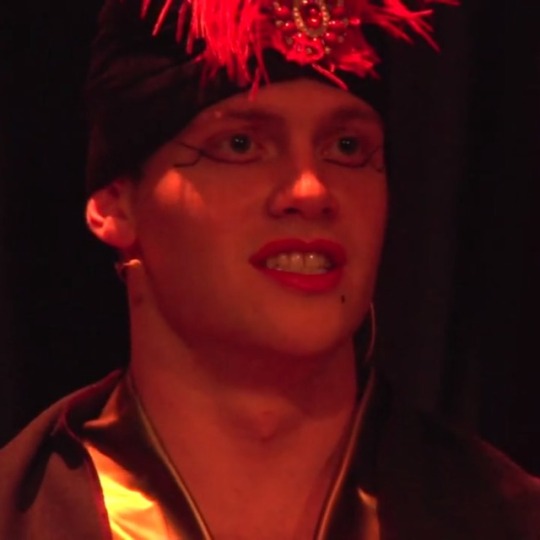





You speak of a... "Golden Rule"? Well, we have our own golden rule here. Whoever has the gold... makes the rules.
#joe walker#starkid#team starkid#twisted#twisted the untold story of a royal vizer#twisted: the untold story of a royal vizier#does the old vizer have a name???
146 notes
·
View notes
Text
Notable Provinces and Clients of the Sublime Esheri Commonwealth
Because I always do these in sets of three, right?
Central: Enlightened Esher, the Clockwork Republic itself, the seat of Reason’s reign. The beating heart of the Commonwealth, where vizers and imperial committees meet under their cool and distant stars, working selflessly and ceaselessly to drown the world in formulae and ink. Sitting on a narrow straight joining two continents, it is well served by trade networks, grand canals and aqueducts stretching inland to sustain the largest concentrated population the world has ever seen. Its suburbs and hinterlands are vast enough to have subsumed cities that were once distant, and are as close to perfectly ordered as human effort has yet achieved, the roads wide and level, the soil fertile, the weather and climate decided and prepared for well in advance.
The Sympona: Properly speaking an archaic name for a region that no longer officially exists, Sympona roughly refers to the region of old imperial conquests, from whose populations the Janissary Corps was originally conscripted. Governed thoroughly and well by the Commonwealth since its creation, its cities are by now nearly as Enlightened as the central heartland – the only real remnants of their old culture the language that loan words were plucked from to fill all the gaps in universal standard, and the exact particulars of sanctioned local festivals. Rational governance of the countryside remains an issue in certain wild reaches – most dangerously where small gods and parasitic spirits survive in hiding, manipulating peasant superstition to coerce obeisance and sacrifice from them.
Old Esher: The eastern reaches of the old Empire, and the original homeland of the Esheri people themselves. Central authority was enforced after the Revolution only after a rather brutal military campaign and a few rather unpopular compromises. To this day, prominent families and clans have sustained themselves from the old aristocracy, and dominant the local governorship and offices. The administrative Committee of the South-East has a reputation for being lured into complacency or corruption by the old lines, and on multiple occasions the Public Safety and the Secretariat have felt the need to dispatch their own agents to monitor or intervene directly.
The Maahiri: The first great triumph of the Commonwealth in foreign affairs was spreading their Enlightenment to one of the old empire’s eternal rivals. The Maahiri shahs were relied on their slave-soldiers as much as the old empire had, though they had by the end grown into a complacent and corrupt aristocracy of their own, feuding with powerful noble clans and the ‘Knives of Paradise’, a powerful deiphage cult in intrigues that left the shahs themselves puppets with a remarkably short life expectancy. Inciting a civil war that broke the rickety edifice of state apart was, when properly undertaken, simplicity itself. After that it was simply a matter of measuring the pace of digestion. While by now largely integrated, some local resistance does remain – most notable descendants or copycats of the Knives.
The Kingdom: A rather desolate land even before its century of troubles, this rugged and hilly region of the old Mishaari lands was the last to be pacified, and has been the source of several particularly blood rebellions in the generations since – the mildly tasteless joke being that, like everything else in the Commonwealth, the revolts come like clockwork on a strict 20-year schedule. The colloquial name comes form the most infamous of the rebellions. The King in White was a particularly potent sorceror whole voluntarily allowed their soul to be consumed and replaced by a Reaper. Even the better part of a century later, scars and ruins are everywhere and obvious, and the native population remains semi-nomadic and in most cases only barely short of open defiance to the central administrators.
The Adylet Protectorate: The so-called ‘Ashen Steppe’ was for a great period the hard border to the Commonwealth’s influence, a permanent state of low-level warfare with the nomadic tribes who raided into settled lands and a trickle of trade caravans bringing goods from the far coast the only notable things to emerge from it. That changed five years ago. A masterful and brutal coup involving the defection of two royals and the simultaneous destruction of the nomad’s three foremost cults has left the Grand Marshall a loyal and devoted ally of the Commonwealth, and the Committee on Unsettled Peoples has been only too happy to provide all the help she requires – both material and scientific – in centralizing power around her new permanent capital and beginning to civilize the region.
Stedry: This mountainous region is, theoretically, much of the direct Illyric frontier with the Commonwealth. It has, for the past few decades, been the site of an increasingly blatant proxy war between the two great powers. The voivodes and bans who rule the various mountains fortresses and valleys owe only loosest allegiance to the Throne, and have historically been as likely to fight an imperial army as rally behind it. This has made turning them without actually starting a war much easier than it would otherwise have been – a matter of providing refuge and deniable amounts of funding and support to forward-thinking claimants, stirring up sympathetic rebellions among the peasantry and artisans, and in a few cases outright orchestrating the overthrow of lords – an angry mob murdering a regent and installing a reasonable man as his replacement in one case, a de facto military coup in another. Maps still show the Stedry as Illyric vassals, generally, but in practice by now trade, education and governance are increasingly carried out on the lines the Committee of General Enlightenment’s ever-present and ever-helpful advisers suggest.
The Aluic Republic: The Commonwealth’s main presence in the Outer World can be uncharitably described as a scientific expedition gone wildly out of hand. The need for safe harbours and resupply on zoological and cartographic surveys naturally lead to seeking friends among native states – something which only became more important as the outer continents were increasingly claimed and exploited under unfriendly flags. Contact with the feuding Aluic city-states solved both problems neatly. Being seemingly the only peoples in the outer continents to have independently developed an alphabet and study of mathematics, they were clearly the foremost champions of civilization available. The sacrificial religion and traditions of sacral kingship were both somewhat disagreeable, but something of a long term problem. As is inevitably the case, a subset of the cities were more than happy to take the aid of flattering strangers against their much despised rivals, and the unification wars progressed quite smoothly. Formally speaking, the Republic is a federation of equal members. In practice, it is an empire with power distributed more or less evenly between the three leading cities (two of the founders and one whose leadership picked an excellent time to switch sides) and the Commonwealth’s ambassador.
The Kingdom of Thuraya: Formerly what was probably the grandest and more powerful of the Soya Principalities, the recent coup has thrown it quite dramatically into the Commonwealth’s orbit. Following several rather humiliating defeats against the Free Cities – first in attempting to assert firm authority over their coastal ports and waters, and then being forced to grant traders free trade and navigation throughout the kingdom – thee scholar-gentry were thrown into turmoil, with increasingly violent anti-foreign movements rising in prominence. Of course, when some of the more pragmatic local governors determined they would need aid to triumph, the Commonwealth was more than happy to discretely provide what they needed. The civil war was swift, if brutal, and the king was safely removed from the grip of his ‘evil advisers’ – having been kept in a comfortable sort of imprisonment in the palace since. The new government still rules in his name, and his seal on the rapid centrilizing and modernizing reforms being undertaken is most likely all that has kept the response to scattered revolts instead of a full-on counterrevolution.
14 notes
·
View notes
Photo


Shoukoku no Altair Liveblog (Chapter 2)
First: I adore how fluid the lines are for this image (left: magazine scan; right: jpn digital ver).
Second: I got my hands on the digital Japanese raws (cmoa.jp was having a sale and the first volume of Altair was free)! It’s surprising how much better the quality is compared to the magazines (see the image above). I guess it would be worth it to buy the digital from Kodansha, though they currently only have the first volume.
Anyway, I have no set way of liveblogging this currently...I planned on doing it in chunks but the posts get really long if I include more than 1 chapter so...I’ll see.
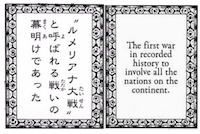
Before I start chapter 2, this is interesting. I noticed that the scans from the magazine lack this border (which appears in both digitally available versions as you can see here). Seems like it really gets cleaned up and added to for the compiled release.
Chapter 2: The Poison General

We get the Balt-Rhein Empire’s crest, but I don’t remember enough about European heraldry to talk about it so I’ll just leave it here.

I love the expressions on these people’s faces. And their poses. They’re probably dancing? I don’t know anything about Turkish dances.
First off, a bit of history about this fictional Turkiye. I have no clue how close it is to the real life counterpart, but apparently this Turkiye is a country of nomads and merchants, which a little wikipedia digging reveals to be true about some Turkish ethnic groups. It also has a “caravan road” and a “sea road” which is the equivalent of the Silk Road.
Breaking away from the exposition, we get some dude calling Mahmut’s name.
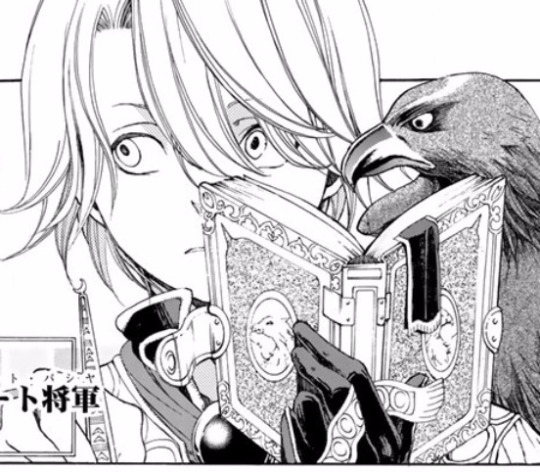
He’s adorable. And he’s reading a book with eagles on the cover, even better. AND he has a bookmark between his fingers. You see it in the book when he closes it, as well as an intricate looking pen. I just love this amount of detail UGH.
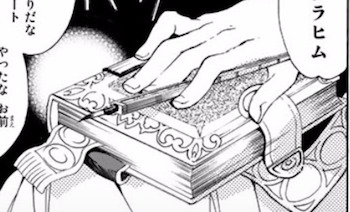
And, I don’t think I mentioned this last chapter, but I loooove how this manga-ka draws birds. They don’t look derpy?? Look at that deadly beak on Iskander.

Then this guy pops up. Ok his nickname is apparently 飾り帽子 meaning “decorated hat” which. I have no clue what that’s supposed to mean. Does he wear nice hats or does he have a lot of accomplishments...I dunno. He’s a governor/viceroy (総督).
Honestly all these titles are starting to confuse me. Are the vizers and pasha two different titles? Because they use the same kanji: 将軍 (meaning general) and there are 13 of each. So does that mean they put a 17-year-old in charge of a whole slice of their country?
whatever, I’ll just go with it.
OH so the pasha are vizers, I see...I just had to read a little further haha
Not sure what these two are going on about, but something to do with the country’s security. And things moving around behind the scenes.
They changed Shara’s appearance between the magazine and digital releases:

(digital: left; magazine scan: right)
I’ve never read both versions like this at the same time, so that’s a surprise. And before anyone gets all up in arms, the colors/shading on the magazine release are usually different/darker because they use lesser quality paper. That’s why her skin tone (as well as the background, which is apparent in certain panels) differ.
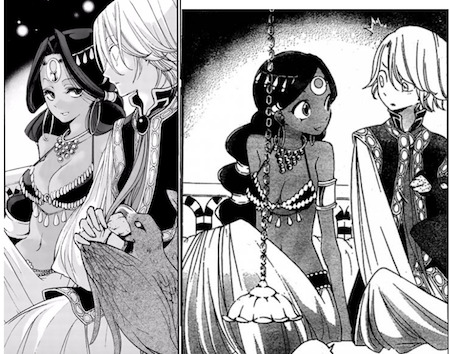
I never realized they differ so much?? Like, I know from other series that they clean up and add chapters to the tankobon but. I kinda like magazine Mahmut’s expression better, but digital Shara is an improvement. She looks a little creepy in the magazine with the very wide eyes lol.
Also Iskander. Mahmut is feeding him...something huge.

Ah, here they are in the panel before. lol that bird.

awww Not a social butterfly, eh. He’d rather sit in a corner feeding his eagle. Honestly, so would I. So would I.
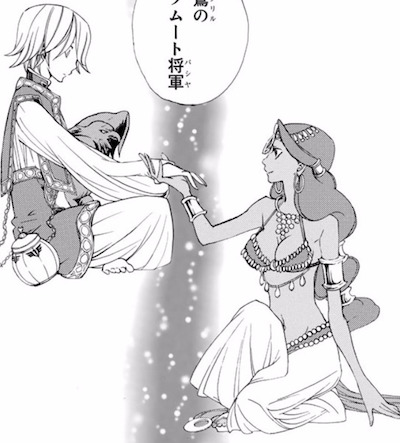
Such a nice panel. Also, she apparently saw him 4 years ago?? He’s about 17 now, so that would make him 13 then. He doesn’t look much different. that’s manga for you.
omg haha poor boy getting dragged off to go dance. Although, he seems really uncomfortable here:
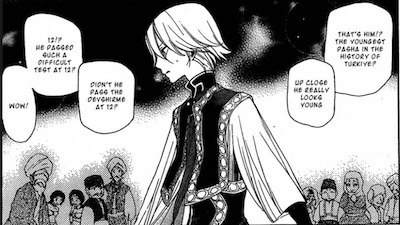
A combination of being embarrassed at his inability to dance and the gossip centered around him?

Maybe it’s just about his dancing after all.
*went to look it up* Ah, yes, apparently it IS part of a dance from that region of the world. People can’t seem to decide if it’s more Turkish or Greek in origin, but whichever it is, that’s apparently how the people in that area danced.
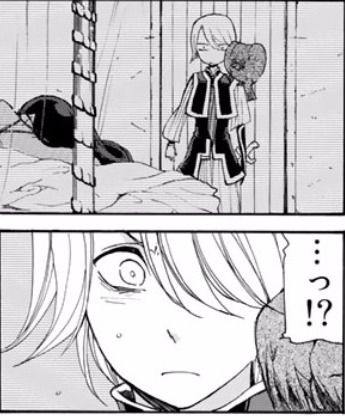
aww he’s flustered.
lol Shara “You know, a pasha’s estate is a lot more modest than I’d thought.”
I actually thought it was a really nice, spacious place if it really is his house that he lives in all alone.
lol his “Get out.”

omg it was a book of poetry??
HAHA so he decided to sleep on the roof instead. What season this? It’s said that they live in a desert, and Ibrahim mentions in the original Japanese that his wife gave birth to twins in the summer, so it isn’t summer...guess it’s not that bad outside haha.
WAIT. You can’t see this in the scans because the sky is too dark, but.

He brought Iskander up there with him.
And serious times now. Looks like that Louis guy from last chapter is up to no good again.
If I knew more about this region, maybe I’d be able to guess who these people are based on, but apparently they’re seeking to reclaim land they’ve lost.

Armed revolt, huh. does not sound good. OH WHAT.
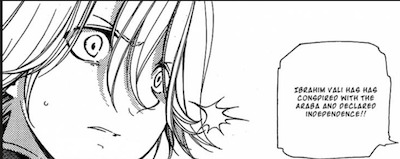
The guy he just spoke to? Aah, that stunned look on his face, especially the crease in his brow, you can see how, well, shocked he is. And shell-shocked, at the bottom of the page when he’s remembering just how easily they hung out together a few days ago.
And notice how, while everyone else is moving onto how they heck they’re going to fix this (with Zaganos already declaring that he’ll take care of it), Mahmut is still in shock that such a thing happened, not wanting to believe it. It shows his lack of experience (the sort that comes with aging with the job). But at the same time, it’s his intense desire for peace that helps him solve these conflicts too. A bit of give and take.
Also, can’t decide if I like this guy or not:

Well, at least he looks cool. I haven’t mentioned it yet, but still loving the clothing designs. Though those boots look painfully annoying to lace up.
Oh, but look at this completely frustrated look.

Once again, he can’t do anything, and no one will even suggest compromise or find out why the people rebelled. Violence is once again the default, the established standard. It clashes completely with how Mahmut wants to approach things.
And then! He doesn’t scream or shout, he actually requests calmly for Zaganos to stop. Not that Zaganos will be pleased, probably, but at least Mahmut is reining himself in. And he waited a bit, too, seeing as Zaganos had time to leave and get on his horse.

He’s using polite language, too.「お待ちくださいザガノス将軍」
Look at this giant unimpressed frown:

Ooh, I really like this tension between the two. He tells Mahmut straight out that he wants to take advantage of this event, whatever caused it, to wipe the optimism/naivety off the pacifist faction’s faces.
“...have their eyes opened to the fact that powers able to make even the virtuous Ibrahim Vali revolt exist in this world.”
I really like that line. It’s hard to really hate the guy because has a point, just as much as Mahmut is right in that they should find out the root of the revolt before they act. It’s horribly cold, but he’s also right that it’s dangerous to, well, believe in the goodness of people when they have the safety of a country at risk, which is the exact opposite of Mahmut.
Of course, the fact that he may have known they would revolt and did not do anything about it just to take advantage of the situation is like, damn dude why are you so cynical. I dunno. Zaganos is interesting. Coldly efficient, extreme, yet I can understand where he’s coming from.
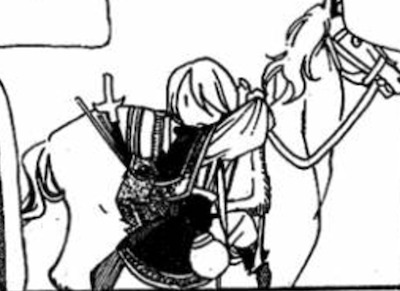
cute
he’s just so. small.
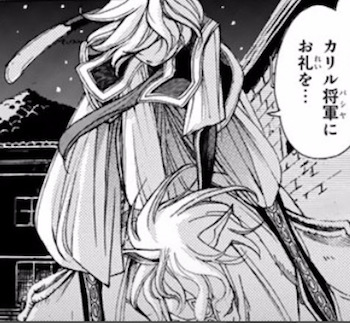
I like this awkward panel in which he is getting on the horse. Looks very weird but. it’s actually accurate for how people experienced at riding (and light enough to vault) look when getting on horses. I appreciate that the horse looks like a horse and not a horse puppet, too (the one other one above notwithstanding)
Also, I love how Halil supports Mahmut, such a great grandfatherly figure.
LANGUAGE TIME OMG. When Mahmut says to tell Halil “Understood” as his message, he uses the word 心得 which translates to “understood” lol. But the kanji that make up that word are 心 “heart” and 得 “to gain”. just...let that sink in (an alternative that is more common is probably 分かりました or 承知, but that’s a little formal)
OMG. She fixed...this awkward horse...it has become so beautiful...Also, the background was changed to make it a starry night.

Ooh, and Shara comes along to help out Ibrahim!
AND I AM DONE. CHAPTER 2 DOWN. How many to go again...? That took forever.
← back・onward →
#shoukoku no altair#the very long altair liveblog#image heavy post#long post#might have to make this a 1 post per chapter thing#im so tired#altair vol 1
13 notes
·
View notes